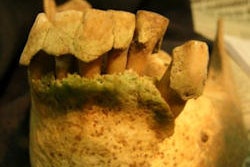The link between tooth development and weaning is not as strong as previous research has suggested, according to a new study published in the Proceedings of the National Academy of Sciences (January 28, 2013).
Scientists studying human evolution have used juvenile primate tooth development as a frame of reference for milestones in early humans. However, the pattern of development from molar eruption to weaning does not fit the fossil record, according to the study authors, from Harvard University.
Chimp studies examining tooth development took place in captivity or by skeletal remains of those in the wild; each have challenges. Captive chimps, according to previous studies, grow more rapidly and reach adulthood three to four years earlier than those in the wild. Consequently, developmental milestones used for reference when studying the development of early human species were inconsistent with those in the wild, where researchers faced the difficult task of pinpointing the age of remains.
However, by tracking chimps in the wild and taking photos of their mouths when open, the researchers were able to track molar eruption and compare it with their behavior. Interestingly, the researchers found that, when their first molar erupts, they were subsequently weaned and began a diet consisting of more solid foods. There was an overlap of adult dietary habits and suckling.



















